Documents: Go to download!
User Manual
- User Manual - (English, French, Spanish)
- Energy Guide - (English)
- Specification Sheet - (English)
- Dimension Guide - (English)
- Warranty Information - (English)
- REFRIGERATOR USE
- REFRIGERATOR FEATURES
- FREEZER FEATURES
- DOOR FEATURES
- REFRIGERATOR CARE
- TROUBLESHOOTING
Table of contents
Owners' Guide Refrigeration
REFRIGERATOR USE
Using the Controls
Your refrigerator has a high-tech, easy-to-use electronic control feature located on the inside of the refrigerator compartment.
The first time you plug in the refrigerator:
The first time you plug in your refrigerator, all of the electronic control indicators will flash simultaneously.
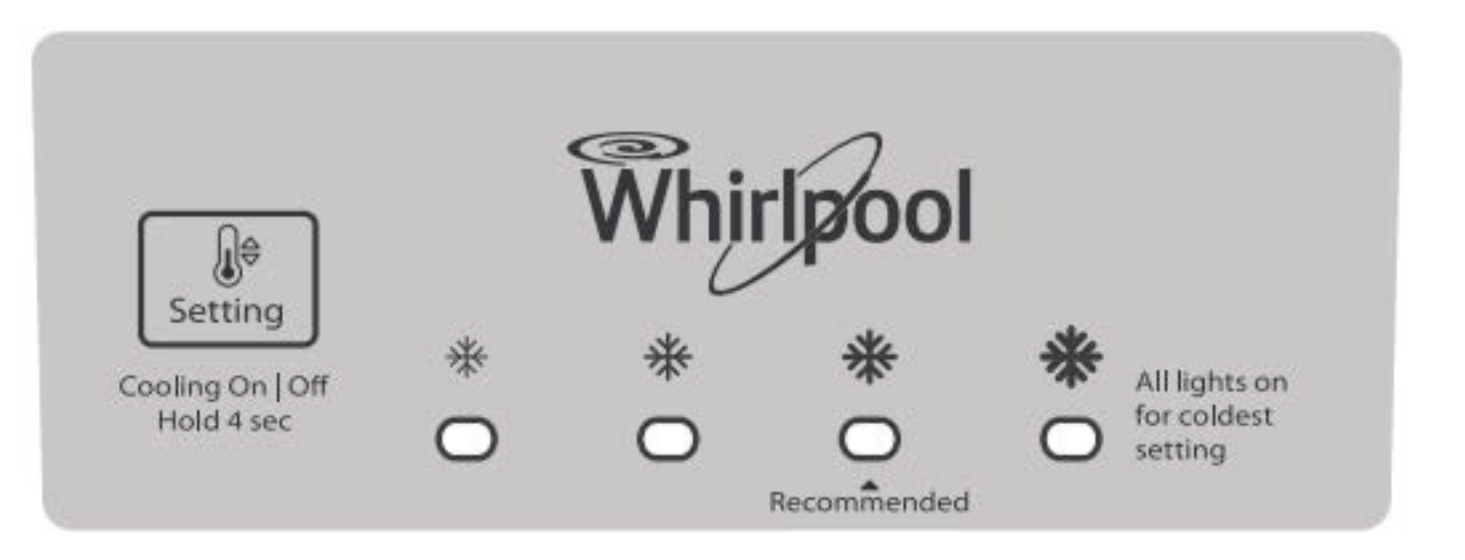
Temperature Control
Your refrigerator is equipped with a Smart temperature control. You can use it to set the refrigerator compartment temperature as needed.
To set the refrigerator compartment temperature:
The product is set to the recommended temperature at the factory. To adjust that temperature, simply press the Setting button. This will decrease the refrigerator temperature. The setting change is unidirectional, from Cold to Coldest (left to right). Once the control is in the Coldest position, it will move to the least-cold setting (Cold) if pressed again.

This is the coldest temperature (Coldest) in the product. All the indicators will be ON.
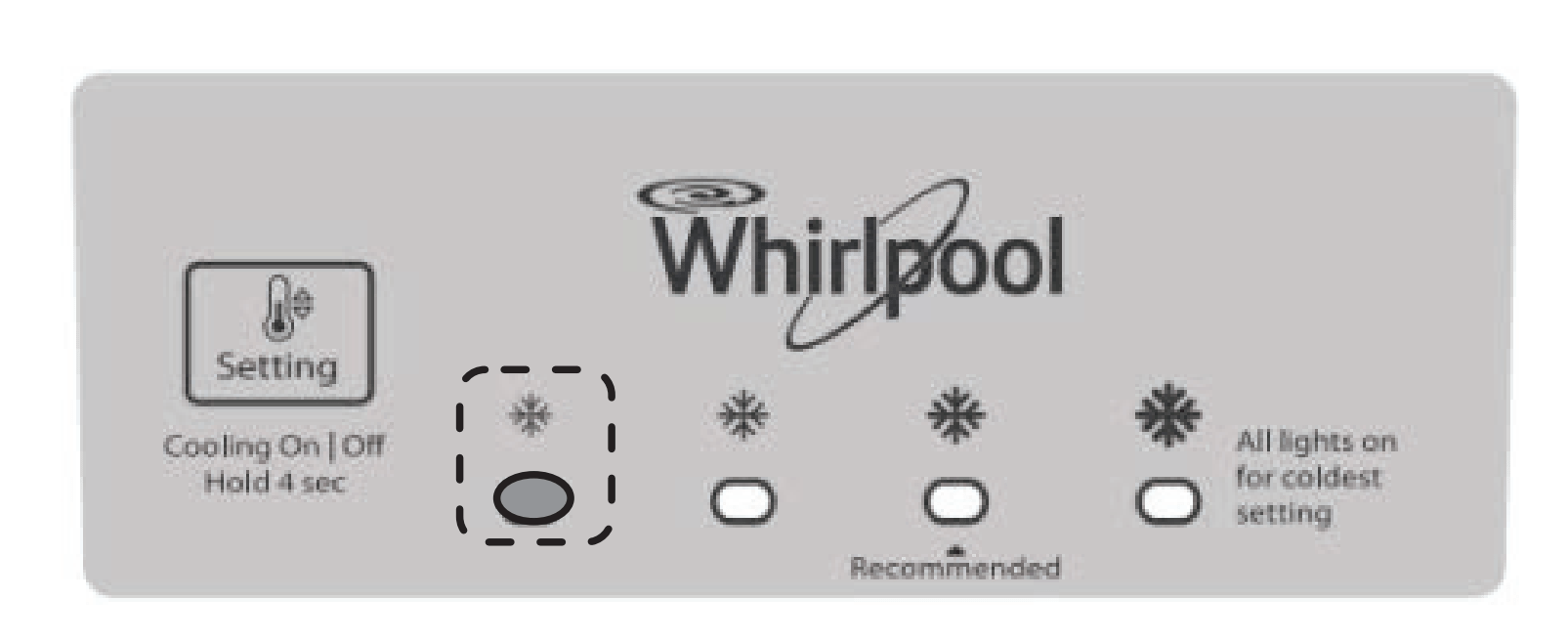
This is the coldest temperature (Coldest) in the product. All the indicators will be ON.
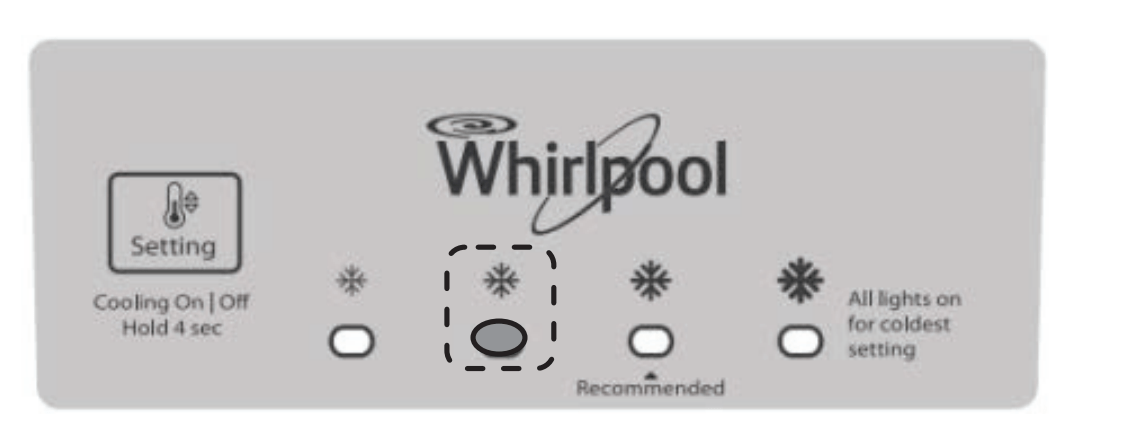
The median minimum temperature will be displayed when you press the Setting button once from the least-cold temperature. The second indicator will be ON.
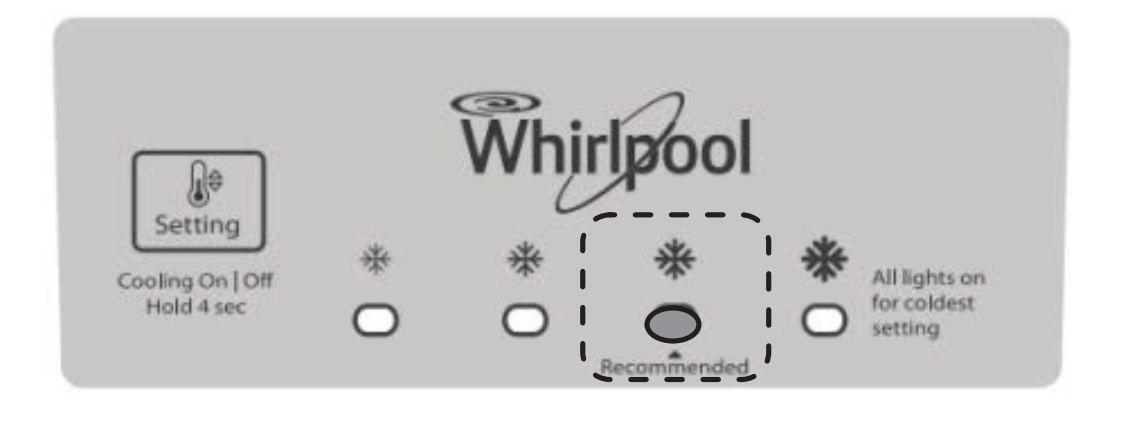
The “Recommended” temperature will be shown with the third indicator ON.
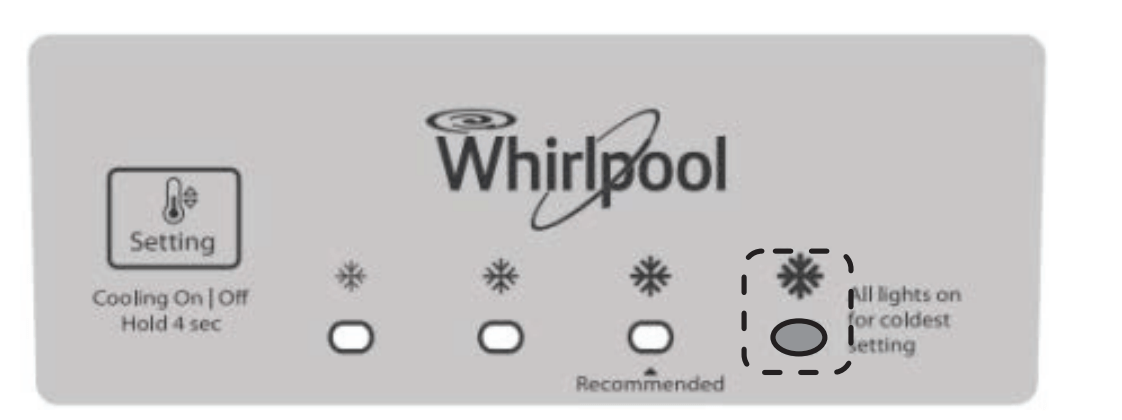
The fourth indicator will come on when you press the Setting button once from the recommended temperature.
NOTE: To switch off the refrigeration system, press the Setting button for 4 seconds and then release it. No indicator will remain on. This will lead the refrigerator and freezer to stop cooling, but the electricity is not disconnected.
To switch the refrigeration system back on, press the Setting button for 4 seconds and then release it.
IMPORTANT:
- Give your refrigerator time to cool down completely before adding food. It is best to wait 24 hours before you put food into the refrigerator. NOTE: Adjusting the Temperature control to a higher (colder) setting will not cool the compartments any faster.
- If you add food before the refrigerator has cooled completely, your food may spoil.
Adjust the Temperature Control
The mid-settings should be correct for normal household usage. The controls are set correctly when milk or juice is as cold as you like and ice cream is firm.
If the temperature is too warm or too cold in the refrigerator or freezer, first check the air vents to be sure they are not blocked.
If you need to adjust temperatures, use the settings listed in the chart below as a guide. On models with two controls, adjust the refrigerator temperature first. Wait at least 24 hours between adjustments and then recheck the temperatures.
| CONDITION/REASON: | ADJUSTMENT |
|
REFRIGERATOR section too warm - Door opened often, large amount of food added or room temperature very warm |
Adjust REFRIGERATOR control one setting higher. |
|
FREEZER section too warm/ice not made fast enough - Door opened often, large amount of food added, or very cold room temperature (can’t cycle often enough) - Heavy ice usage |
Adjust AIRFLOW or REFRIGERATOR control one setting higher. |
|
REFRIGERATOR section too cold - Controls not set correctly for your conditions |
Adjust REFRIGERATOR control one setting lower |
|
FREEZER section too cold - Controls not set correctly for your conditions |
Adjust AIRFLOW or REFRIGERATOR control one setting lower. |
Airflow Control
The Airflow control regulates the amount of air flowing between the freezer and the refrigerator compartments.
When you plug in the refrigerator for the first time, turn the Airflow control to the Recommended setting.
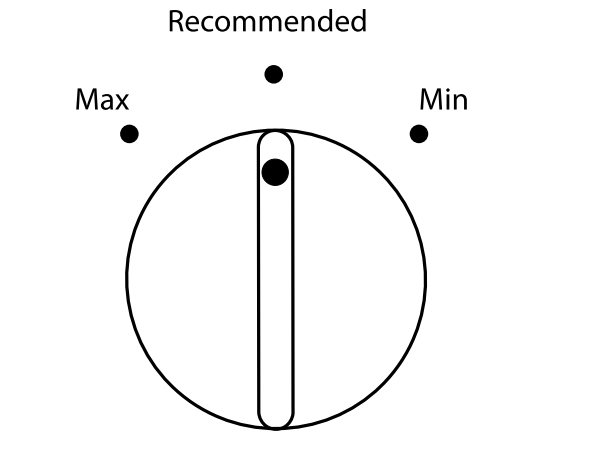
Adjust the Airflow Control
If you want to temporarily increase the cold air flow to a specific compartment, adjust the control.
- Max - Increase airflow to the freezer.
- Min - Increase airflow to the refrigerator.
IMPORTANT: Once the performance is achieved, return the Airflow control to the Recommended setting to keep the refrigerator operating at optimum efficiency.
| CONDITION/REASON | ADJUSTMENT |
| Heavy ice use | Max |
| Hot room temperature | Max - To maintain ice making production rate |
| Large quantity of groceries | Min - To quickly chill food and beverages |
Ice Maker (on some models)
Turning the Ice Maker On/Off
NOTE: Do not force the wire shut-off arm up or down.
- To turn on the ice maker, simply lower the wire shut-off arm. NOTE: Your ice maker has an automatic shutoff. As ice is made, the ice cubes will fill the ice storage bin and the ice cubes will raise the wire shut-off arm to the Off (arm up) position.
- To manually turn off the ice maker, lift the wire shut-off arm to the Off (arm up) position and listen for the click to make sure the ice maker will not continue to operate.
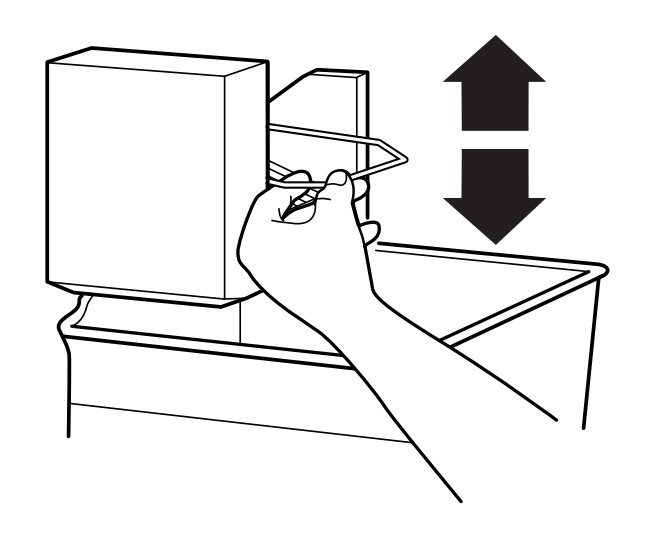
NOTE: Turn off the ice maker before removing the ice storage bin to serve ice or to clean the bin. This will keep the ice cubes from dropping out of the ice maker and into the freezer compartment. After replacing the ice storage bin, turn on the ice maker.
Ice Production Rate
- NORMAL Ice Production: The ice maker should produce approximately 8 to 12 batches of ice in a 24-hour period. If ice is not being made fast enough, turn the Freezer control toward a higher (colder) number in half number steps. (For example, if the control is at 3, move it to between 3 and 4.) Wait 24 hours and, if necessary, gradually turn the Freezer control to the highest setting, waiting 24 hours between each increase.
- MAXIMUM Ice Production (on some models): The ice maker should produce approximately 16 to 20 batches of ice in a 24-hour period. If your refrigerator has the maximum ice production feature, push the switch to MAX.
Remember
- Allow 24 hours to produce the first batch of ice. Allow 3 days to completely fill the ice storage bin. Discard the first three batches of ice produced.
- The quality of your ice will be only as good as the quality of the water supplied to your ice maker. Avoid connecting the ice maker to a softened water supply. Water softener chemicals (such as salt) can damage parts of the ice maker and lead to poor quality ice. If a softened water supply cannot be avoided, make sure the water softener is operating properly and is well maintained.
- Do not store anything on top of the ice maker or in the ice storage bin.
REFRIGERATOR FEATURES
Your model may have some or all of these features.
Important information to know about glass shelves and covers:
Do not clean glass shelves or covers with warm water when they are cold. Shelves and covers may break if exposed to sudden temperature changes or impact, such as bumping. Tempered glass is designed to shatter into many small, pebble-size pieces. This is normal. Glass shelves and covers are heavy. Use both hands when removing them to avoid dropping.
Refrigerator Shelves (Glass shelves on some models)
The shelves in your refrigerator are adjustable to match your individual storage needs.
Storing similar food items together in your refrigerator and adjusting the shelves to fit different heights of items will make finding the exact item you want easier. It will also reduce the amount of time the refrigerator door is open and save energy.
Shelves and Glass Shelves (on some models)
To remove and replace a shelf:
- Remove items from the shelf.
- Slide the shelf straight out to the stop.
- Depending on your model, lift back or front of the shelf past the stop. Slide shelf out the rest of the way.
- Replace the shelf by sliding the back of the shelf into the track in the wall of the cabinet.
- Guide the front of the shelf into the shelf track. Be sure to slide the shelf in all the way

Deli Drawer (on some models)
To remove and replace the deli drawer:
- Slide deli drawer out to the stop.
- Lift front of deli drawer with one hand while supporting bottom of drawer with other hand. Slide drawer out the rest of the way.
- Replace the drawer by sliding it back in fully past the drawer stop
Deli Drawer Cover (on some models)
To remove and replace the deli drawer cover:
- Remove the deli drawer.
- Push the cover back to release the rear clips from the shelf. Tilt the cover up at the front and pull it forward.
- Replace the deli drawer cover by fitting the notches and clips on the cover over the rear and center crossbars on the shelf.
- Lower cover into place and pull the cover forward to secure the rear clips onto the shelf.
- Replace the deli drawer.
NOTE: In some models the deli drawer moves sideways on the shelf to allow for flexible positioning

Meat Storage Guide
Store most meat in original wrapping as long as it is airtight and moisture proof. Rewrap if necessary. See the following chart for storage times. When storing meat longer than the times given, freeze the meat.
Fresh fish or shellfish....................... Use same day as purchased.
Chicken, ground beef, variety meats (liver) ......................1-2 days
Cold cuts, steaks/roasts ..................................................3-5 days
Cured meats...................................................................7-10 days
Leftovers - Cover leftovers with plastic wrap, aluminum foil, or plastic containers with tight lids.
Crisper
Crisper Drawers
To remove and replace the crisper drawer:
- Slide the crisper drawer straight out to the stop. Lift the front and slide the drawer out the rest of the way.
- Replace the drawer by sliding the drawer in fully past the stop.
Crisper Cover
Style 1 - Plastic Cover
To remove and replace the crisper cover:
- Remove the crisper(s).
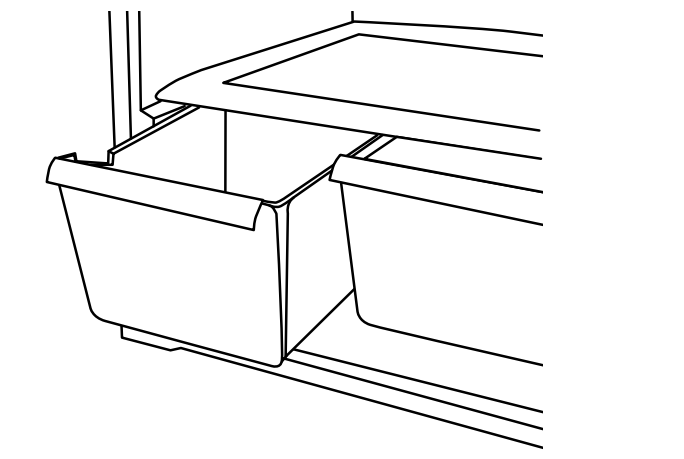
- Lift the cover up and slide it out
- Replace the cover by fitting the cover tabs into lowest cabinet slots and pushing them in. Lower the front retainers into place.

Style 2 - Glass Cover
To remove and replace the crisper cover:
- Pull the glass straight out.
- Replace the glass by pushing it straight in.
FREEZER FEATURES
Your model may have some or all of these features.
Important information to know about glass shelves and covers:
Do not clean glass shelves or covers with warm water when they are cold. Shelves and covers may break if exposed to sudden temperature changes or impact, such as bumping. Tempered glass is designed to shatter into many small, pebble-size pieces. This is normal. Glass shelves and covers are heavy. Use both hands when removing them to avoid dropping.
Freezer Shelf (on some models)
To remove and replace the freezer shelf:
- Remove items from the shelf.
- Lift back of shelf over stop and slide shelf straight out.
- Replace the shelf by sliding the back of the shelf into the tracks on walls of cabinet.
- Be sure to slide the shelf in all the way

Frozen Food Storage Guide
Storage times will vary according to the quality and type of food, the type of packaging or wrap used (should be airtight and moisture proof), and the storage temperature. Seal the package or container securely to avoid taste and odor transfer throughout the product. Ice crystals inside a sealed package are normal. This simply means that moisture in the food and air inside the package have condensed, creating ice crystals.
Put no more unfrozen food into the freezer than will freeze within 24 hours (no more than 2 to 3 lbs of food per cubic foot [907 to 1,350 g per L] of freezer space). Leave enough space in the freezer for air to circulate around packages. The freezer door must close tightly.
NOTE: For more information on preparing food for freezing, check a freezer guide or reliable cookbook.
DOOR FEATURES
Your model may have some or all of these features.
Door Rails
The door rails may be removed for easier cleaning.
Snap-On Door Rails (on some models)
To remove and replace the rails:
- Depending on your model, remove the rails by pushing in slightly on the front of the bracket while pulling out on the inside tab. Repeat these steps for the other end.
- Replace the rails by aligning the ends of the brackets with the buttons on the sides of the door liner. Firmly snap bracket and assembly onto the tabs above the shelf as shown.

Drop-In Door Rails (on some models)
To remove and replace the rails:
- Remove the rails by pulling straight up on each end of the rail.
- Replace the rails by sliding the shelf rail into the slots on the door and pushing the rail straight down until it stops.

REFRIGERATOR CARE
Cleaning
WARNING
Explosion Hazard
- Use nonflammable cleaner.
- Failure to do so can result in death, explosion, or fire
Both the refrigerator and freezer sections defrost automatically. However, clean both compartments about once a month to avoid buildup of odors. Wipe up spills immediately.
IMPORTANT: Because air circulates between both sections, any odors formed in one section will transfer to the other. You must thoroughly clean both sections to eliminate odors. To avoid odor transfer and drying out of food, wrap or cover foods tightly.
To Clean Your Refrigerator:
NOTE: Do not use abrasive or harsh cleaners such as window sprays, scouring cleansers, flammable fluids, cleaning waxes, concentrated detergents, bleaches, or cleansers containing petroleum products on plastic parts, interior and door liners, or gaskets. Do not use paper towels, scouring pads, or other harsh cleaning tool.
- Unplug refrigerator or disconnect power.
- Hand wash, rinse, and dry removable parts and interior surfaces thoroughly. Use a clean sponge or soft cloth and a mild detergent in warm water.
- Wash stainless steel and painted metal exteriors with a clean sponge or soft cloth and a mild detergent in warm water. Dry thoroughly with a soft cloth. NOTE: To keep your stainless steel refrigerator looking like new and to remove minor scuffs or marks, it is suggested that you use the manufacturer’s approved Stainless Steel Cleaner and Polish. To order the cleaner, see the “Accessories” section.
IMPORTANT: This cleaner is for stainless steel parts only! Do not allow the Stainless Steel Cleaner and Polish to come into contact with any plastic parts such as the trim pieces, dispenser covers, or door gaskets. If unintentional contact does occur, clean plastic part with a sponge and mild detergent in warm water. Dry thoroughly with a soft cloth. - Clean the condenser coils regularly. Coils may need to be cleaned as often as every other month. This may help save energy.
See other models: GXW6536DXS YMEDE300VW KFGS306VSS 4651153 MDB7959SHK
Pull refrigerator out away from the wall. See “Unpack the Refrigerator.”
Vacuum coils when they are dusty or dirty.
Roll refrigerator back into place. Make sure to leave 1" (2.5 cm) between the cabinet back and the wall.
Check to see that the refrigerator is level. - Plug in refrigerator or reconnect power.
Changing the Light Bulbs
NOTE: Not all appliance bulbs will fit your refrigerator. Be sure to replace the bulb with an appliance bulb of the same size, shape, and wattage (no greater than 40 watts).
Refrigerator Light
- Unplug refrigerator or disconnect power.
- Reach behind the control panel and unscrew the bulb.
- Replace the LED bulb or one appliance bulb MAX 40 watt. 4. Plug in refrigerator or reconnect power.
- Plug in refrigerator or reconnect power.

Vacation and Moving Care
Vacations
If You Choose to Leave the Refrigerator On While You’re Away:
- Use up any perishables and freeze other items.
- If your refrigerator has an automatic ice maker and is connected to the household water supply, turn off the water supply to the refrigerator. Property damage can occur if the water supply is not turned off.
- If you have an automatic ice maker, turn off the ice maker.
NOTE: Raise the wire shut-off arm to Off (up) position. - Empty the ice bin.
If You Choose to Turn Off the Refrigerator Before You Leave:
- Remove all food from the refrigerator.
- If your refrigerator has an automatic ice maker:
■ Turn off the water supply to the ice maker at least one day ahead of time.
■ When the last load of ice drops, raise the wire shut-off arm to the Off (up) position. - Turn off the Temperature controls. See “Using the Controls.”
- Clean refrigerator, wipe it, and dry well.
- Tape rubber or wood blocks to the tops of both doors to prop them open far enough for air to get in. This stops odor and mold from building up.
Moving
When you are moving your refrigerator to a new home, follow these steps to prepare it for the move.
- If your refrigerator has an automatic ice maker:
■ Turn off the water supply to the ice maker at least one day ahead of time.
■ Disconnect the water line from the back of the refrigerator.
■ When the last load of ice drops, raise the wire shut-off arm to the Off (up) position. - Remove all food from the refrigerator and pack all frozen food in dry ice.
- Empty the ice bin.
- Turn off the Temperature controls. See “Using the Controls.”
- Unplug refrigerator.
- Clean, wipe, and dry thoroughly.
- Take out all removable parts, wrap them well, and tape them together so they don’t shift and rattle during the move.
- Depending on the model, raise the front of the refrigerator so it rolls more easily OR raise the leveling screws so they don't scrape the floor. See “Adjust the Door(s).”
- Tape the doors closed and tape the power cord to the back of the refrigerator.
When you get to your new home, put everything back and refer to the “Installation Instructions” section for preparation instructions. Also, if your refrigerator has an automatic ice maker, remember to reconnect the water supply to the refrigerator.
TROUBLESHOOTING
Contact us by mail with any questions or concerns at the address below:
In the U.S.A.:
Whirlpool Brand Home Appliances
Customer eXperience Center
553 Benson Road Benton Harbor, MI 49022-2692
Please include a daytime phone number in your correspondence.
In Canada:
Whirlpool Brand Home Appliances
Customer eXperience Centre
200 – 6750 Century Ave.
Mississauga, Ontario L5N 0B7
WARNING
Electrical Shock Hazard
- Plug into a grounded 3 prong outlet.
- Do not remove ground prong.
- Do not use an adapter.
- Do not use an extension cord.
- Failure to follow these instructions can result in death, fire, or electrical shock.
WARNING
Explosion Hazard
- Use nonflammable cleaner.
- Failure to do so can result in death, explosion, or fire.
| If you experience | Possible Causes and/or Recommended Solutions |
| The refrigerator will not operate |
|
| The motor seems to run too much | Your new refrigerator may run longer than your old one. Energy-efficient refrigerators run longer at lower, more energy-efficient speeds. Your refrigerator may run even longer if the room is warm, a large food load is added, the door is opened often, or if the door has been left open. |
| The refrigerator is noisy |
Refrigerator noise has been reduced over the years. Due to this reduction in operating noise, you may notice unfamiliar noises that are normal. Following are some normal sounds with an explanation:
|
| The door will not close completely | The door is blocked open - Move food packages away from door. Push bin or shelf back into the correct position. Make sure the crisper cover is fully pushed in so that the back rests on the supports. |
| The door is difficult to open | Gaskets are dirty or sticky - Clean gaskets and contact surfaces with mild soap and warm water. Rinse and dry with soft cloth. |
| Temperature is too warm |
|
| There is interior moisture buildup NOTE: Some moisture buildup is normal. |
|
| The ice maker is not producing ice or not enough ice (on some models) |
|
| The ice cubes are hollow or small (on some models) NOTE: This is an indication of low water pressure. |
|
| Off-taste, odor, or gray color in the ice (on some models) |
|

